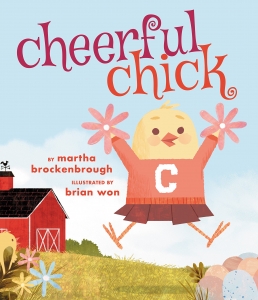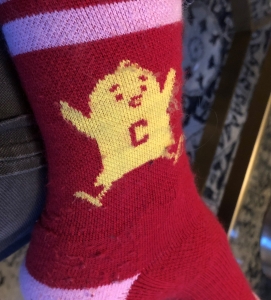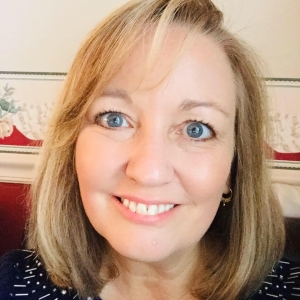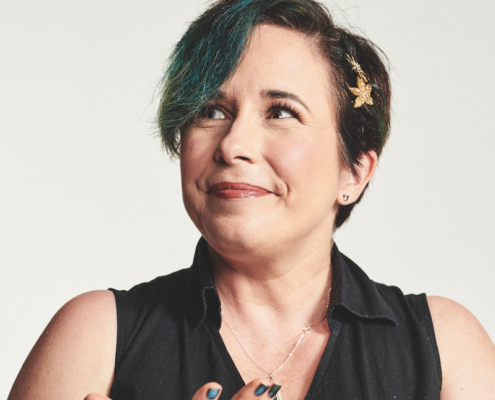Release Interview: CHEERFUL CHICK by Faculty Martha Brockenbrough
Rah-Rah! Go-Team-Win! Cheerful Chick makes readers grin!
What (or perhaps who) was the inspirational spark for writing this delightful picture book?
For many years, I’ve had a dear friend and partner in the creative trenches, Jolie Stekly. We met through the Society of Children’s Book Writers & Illustrators, and we work together on the organization’s social media team. Once when we were at a conference together, I attempted a cheerleading move called a herkie. I meant to amuse Jolie, a former cheerleader. But I ended up reminding her more of a chicken in distress. And that’s how the idea came to me… a chicken who loved to cheer struck me as a funny concept.
What audience (age/personality…) were you thinking of as readers who’d be inspired to be themselves? By this I mean, was there a specific “reason” that you wanted this story to be in the world?
With picture books, I often start with concepts that entertain me. The Dinosaur Tooth Fairy was the answer to a big question: What if dinosaurs had tooth fairies? Back to School with Bigfoot imagined the problems he would have … the endless back-to-school haircut, the difficulty of finding shoes that fit. Once I have a concept that delights me, I think about some aspect of being a little kid that has emotional resonance. The Dinosaur Tooth Fairy is a story about finding a friend who loves what you love. Bigfoot is about anxiety and rising above it. Cheerful Chick is about how we sometimes have to persevere in our dreams when they aren’t shared, and how we often meet our best friends along the way. All of these emotional landscapes are ones I’ve experienced and explored in my life, and that’s what I wanted to write about for little kids.
Did you plan to write in rhyme from the beginning? When you chose rhyme, how did you select your meter? Was this difficult, and if so, what super powers did you employ to overcome those difficulties?
The first draft wasn’t in rhyme. And the chick was a chicken, because I thought it would be super funny if an egg dropped out every time she jumped. I still think that’s funny, but sometimes editors think I am not remotely hilarious. One of them observed that “chicken wasn’t a very good mother,” while saying nothing about the absentee rooster, and honestly, I still in a bit of a snit about this. Anyway, my editor Arthur Levine asked me to try it in rhyme, and after the opening came to me—Once inside a chicken’s nest, a dozen eggs, all Grade A best…—I had my rhyme scheme. I wanted something that echoed the pattern of familiar cheers, and so it suited. I would call it iambic tetrameter.
It wasn’t hard to choose, and a rough and imperfect draft came fairly quickly. I knew the story, as I’d already written it in prose. I’ve been playing with rhyme and meter for a really long time. When I was in 8th grade, my English teacher used to give us vocab lists that we were supposed to include in sentences. I used to write mine as a poem. I was, frankly, more excited by that than the vocab, and I once handed in the assignment without actually using any of the vocab words. OOPS! In college, I studied ancient Greek, and part of the work of learning the language and the various epic poems and plays was in scanning the meter, so I got very familiar with it. This served well when it came time to study Shakespeare—I took a class in performance in college. That seemed like more fun than writing papers. And my college roommate and I used to sit around and talk to each other in iambic pentameter. The thread that runs through this is that playing with language has been my favorite sport since I was a kid. And I think that’s how we have to view this, as play. These creative constraints are what make us come up with solutions we might not otherwise have landed on, and the zing I get from that is deeply satisfying.
Can you tell us a bit about working with illustrator Brian Won? What was your reaction to his illustrations when you first saw finished pieces?
I love, love, love Brian. I met him years ago when I was in Los Angeles. My girls were for a time represented by a talent agent, and we’d spend six-weeks at a time in LA. They’d wait for auditions, and I’d drive them and homeschool them, and it was quite the adventure. The LA community of writers is fabulous—people like Dan Santat, Lisa Yee, Ken Min, and Brian, and they have breakfasts and were kind enough to include me. I was sitting next to Brian and he’d brought along a dummy for the book that became Hooray for Hat! He showed it to me and I was so blown away by it. When Arthur Levine suggested Brian might be a suitable illustrator, I definitely did a herkie. And I was so glad he said yes. I think the illustrations are perfect. They’re funny, they tell a secondary story, and the palette is beautiful. Chick is so adorable that I actually had socks made with her on them.
Your first semester as an advisor was my second as a student and we were (luckily for me!) paired by the magic hat! What has your VCFA experience been like? What are your favorite things about this position?
I was so lucky to have you as a student, Laurel. What a perfect introduction to the program you were. You transformed your writing and for me, that was proof that the program works. There is a reason to do all of this work: the reading, the critical thinking, the creative volume, the workshops. This is how we get better at the craft. And I have learned right alongside you. I was, frankly, blown away by the quality of the graduate lectures my first semester as a teacher. They were of a higher quality than I’d seen elsewhere. And I think this is one of the powerful things about being part of the community. The bar is high. We keep raising it as we deepen our understanding of craft in its infinite dimensions. And this is for the benefit of young readers.
I have to say; this Cheerful Chick reminds me an awful lot of you! You march to the beat of your own drummer with gusto, and you enthusiastically encourage your VCFA students to do the same. Do you see a resemblance, too?
Aw, thank you. I am absolutely a cheerleader for my students and for everyone in this community. This is beautiful, important work we do and it is a profoundly wonderful way to spend a life. When we do it well, we feed minds and hearts and do it in a way that doesn’t exploit, pollute, or diminish. I do think many facets of myself appear in the book. I am sometimes busy at my trough. I’m sometimes distracted. Sometimes grumpy. Sometimes tired. At the end of the day, as at the end of the book, I do try to have it together enough to cheer at the wonder of being alive with the souls I love most.
What advice would you give to incoming or prospective VCFA students who want to write (rhyming or prose) picture books?
Familiarize yourself with rhythm. We generally know what rhymes (this can be tricky, of course, because accents and dialect can get in the way). But really work on that rhythm and you will have a pleasing text even if you choose not to rhyme it.
It’s also good to know the story you want to write without the pressure of having it rhyme. Who’s your character? What do they want? Why? What’s their obstacle? How does their journey of trying/learning unfold?
Then, a good rhyming dictionary can be a great help. Rhymezone.com has been a handy tool for me.
Is there anything else you want to share about the process of getting Cheerful Chick into the hands of readers?
This book was rejected many times for stupid reasons. This is what happens a lot with picture books. The market is just tough, and if an editor can find a reason to pass, they will. And it can be discouraging. Imagine hearing the character you’ve written isn’t a good mom. Or that the book is shallow. Or that everyone knows chicken eggs take 23 days to hatch, and young readers will find this unrealistic. (Yes, this is what one editor said.) It is perhaps uncharitable of me to use these responses to make you laugh, but that’s really all we can do with criticism. Not everyone will love your work. But if you write enough books and get good enough with your vision and execution, you will find an editor.
I literally have folders hundreds of drafts of scores of PBs I have written. The world doesn’t need all of them, but I’ve needed to write them all to understand how this challenging form works. Also? It’s been fun. And I’m never going to stop playing with words.
Cheerful Chick was published by Arthur A. Levine Books, January 1, 2019.
Martha Brockenbrough is the award-winning author of fiction and nonfiction for young readers and adults. Her novel The Game of Love and Death (Scholastic) was a finalist for the Kirkus Prize and a winner of the Pacific Northwest Bookseller Association and Washington State Book awards, as well as a YALSA Top 10 Readers Choice Award. She has also written nonfiction titles Finding Bigfoot and Shark Week (both Feiwel & Friends), the YA novel Devine Intervention (Scholastic),and the picture book The Dinosaur Tooth Fairy (Scholastic). Forthcoming titles include Alexander Hamilton: Revolutionary (Feiwel & Friends); Back to School with Bigfoot (Scholastic); and Love, Santa (Scholastic). She’s worked as a journalist, editor, teacher, and question-writer for Cranium and Trivial Pursuit, and she founded National Grammar Day.









